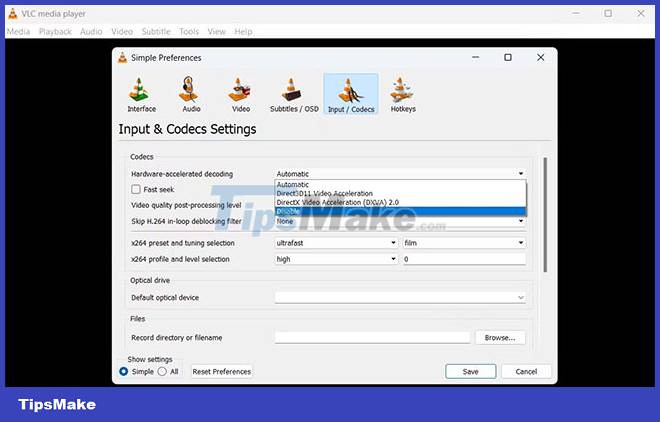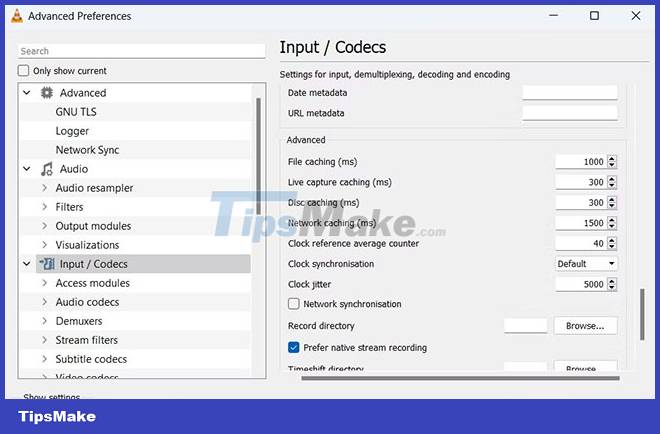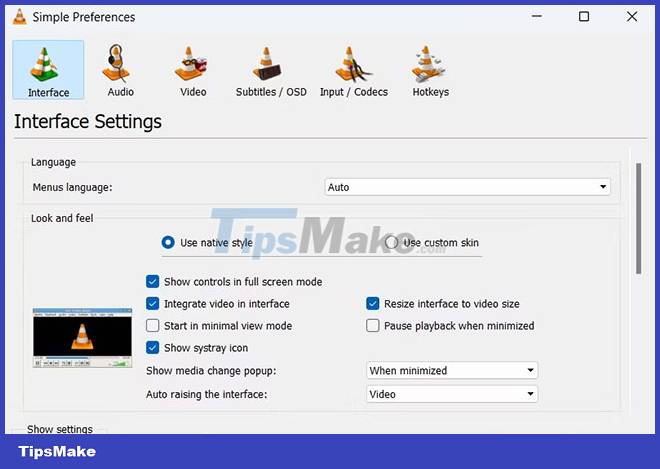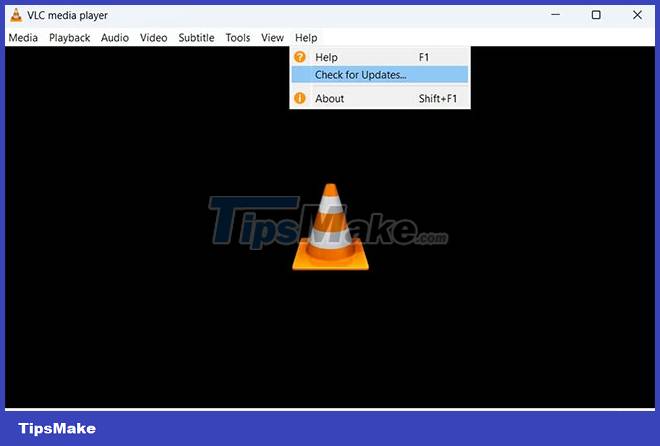How to fix the error VLC Media Player does not play videos on Windows 11
Although it may take some time, it will be quicker to resolve this than downloading and setting up a new media player. If you are in a similar situation, read on to learn how you can fix VLC Media Player on Windows 11.
1. Check the file format
VLC Media Player is compatible with many video formats, but not all of them. If you try to play an unsupported video format on VLC, it will show a black screen or an error message. You can visit the official VLC features website to learn about the different file formats the tool supports.
If VLC doesn't support your chosen video format, you can use an online video converter to turn it into the format you want.
2. Disable hardware acceleration on VLC
VLC comes with hardware acceleration that speeds up the encoding and decoding of certain types of videos. However, it can cause compatibility issues on some computers, especially those with faulty hardware drivers.
So if you're having trouble playing videos in VLC, disabling hardware acceleration might be a good solution. To turn off this feature, follow these steps:
Step 1: Open VLC Media Player.
Step 2: Click Tools and select Preferences from the context menu. You can also press the Ctrl + P hotkey to open the VLC Preferences window .

Step 3: Switch to Input / Codes tab .
Step 4: In the Codec section , click the drop-down arrow next to Hardware-accelerated decoding and select Disable.

Step 5: Click Save.
Now, relaunch VLC Media Player and check if you can play any video. If not, try the next solution on the list.
3. Change the File Catching and Network Catching values
While streaming over the Internet, VLC stores a small amount of content on the system, which helps it to provide continuous playback even if the connection is interrupted. If VLC can't play streaming video, it can be said that the current network cache size is not large enough for the video. This situation mainly arises when you try to stream a large video.
The solution in this case is to increase the network cache size. To increase the network cache size in VLC, follow the instructions below.
Step 1: Open the Preferences window of VLC Media Player.
Step 2: Switch to Input / Codecs tab .
Step 3: Click the All button in the Show settings section.

Step 4: Select Input / Codecs from the left panel.
Step 5: In the right panel of the window, find Network caching (ms) . It will be in the Advanced section.
Step 6: Change the Network caching value to 1500.

Step 7: Click Save.
A similar problem can arise with videos stored on the local hard drive. If the video you are trying to play is large (over 15GB), VLC will have trouble loading it and cause problems. The situation mainly arises when other programs or operating systems use most of the available disk space.
To solve this problem, you will have to increase the file caching size on VLC. Here's how to do it:
Step 1: Go to Preferences > Input / Codecs > press the All button > Input / Codecs .
Step 2: Select Input / Codecs from the left panel.
Step 3: In the right panel, locate File caching (ms) .
Step 4: Change the File caching value to 2000.

Step 5: Click Save.
Check if the problem is fixed or not.
4. Select DirectX (DirectDraw) as default video output mode
By default, VLC keeps the video output mode as OpenGL video output for Windows . But sometimes, this output mode may not play certain types of videos. The solution in this situation is to set the output mode to DirectX (DirectDraw) . To do this, follow the steps below.
Step 1: Open the Preferences window and switch to the Video tab.
Step 2: Click the drop-down icon next to Output and select DirectX (DirectDraw) Video Output Mode from the context menu.

Step 3: Check the box before the Accelerated video output (Overlay) and Use hardware YUV -> RGB conversions options .

Step 4: Click Save.
5. Reset VLC options
The preferences file stores all the important settings for VLC. If it has been corrupted for some reason, VLC will start to behave abnormally. It may not play the video or certain commands will not work as expected.
Fortunately, you can quickly bring VLC back to its original healthy state by resetting the preferences file. To do this, open the Preferences window and click Reset Preferences at the bottom of the screen. Confirm your choice by clicking the OK button from the prompt that appears.

Next, restart VLC Media Player and check if you can play the video.
6. Download the latest VLC update
VLC regularly receives updates to fix bugs, add features, etc. If VLC can't play videos due to bugs in the application, downloading the latest update can be an effective solution.
Here's how to update VLC Media Player:
Step 1: Open VLC and click the Help button in the top bar.
Step 2: Select Check for Updates from the context menu.

7. Reinstall VLC Media Player
If none of the solutions help, there may be an error with the installation file. As a solution, you will have to reinstall VLC Media Player. To do this, open Control Panel and select Uninstall a program . Locate, right-click on VLC Media Player and select Uninstall from the context menu.
Now, go to the official VLC website and download the latest version of the app.
VLC is one of the best media players for Windows. On it, you can play videos in most of the available formats, increase the volume by more than 100%, add various effects and filters to the media content.
However, like any other app, it can crash from time to time. If VLC Media Player cannot play videos on Windows, try the above solutions to fix the problem quickly.
You should read it
- Set up VLC Media Player as the default multimedia player on Windows 10
- Advanced tricks use VLC Media Player
- How to fix 3 problems with VLC Media Player
- How to download and install Windows Media Player 12 on Windows 10
- VLC Media Player 3.0.11
- How to Reinstall Windows Media Player
- 10 interesting hidden functions of VLC Media Player
- Instructions for rotating videos are inverted and inclined by VLC Media Player
May be interested
- Set up VLC Media Player as the default multimedia player on Windows 10
 by default, windows 10 is integrated with windows media player as a multimedia player. however, if you feel too bored with windows media player, you can set up other multimedia players such as vlc media player as a multimedia player on windows 10. to do this, please refer to the article. below of network administration.
by default, windows 10 is integrated with windows media player as a multimedia player. however, if you feel too bored with windows media player, you can set up other multimedia players such as vlc media player as a multimedia player on windows 10. to do this, please refer to the article. below of network administration. - How to download and install Windows Media Player 12 on Windows 10
 some versions of windows 10 do not have windows media player preinstalled. if you are missing this classic windows utility, the following article will show you how to get it back quickly and for free. the article also provides some alternative media players because windows media player has not been updated since 2009.
some versions of windows 10 do not have windows media player preinstalled. if you are missing this classic windows utility, the following article will show you how to get it back quickly and for free. the article also provides some alternative media players because windows media player has not been updated since 2009. - How to play video jigsaw on VLC
 right on vlc media player, there is a feature for playing puzzles with the currently playing video screen.
right on vlc media player, there is a feature for playing puzzles with the currently playing video screen. - 10 interesting hidden functions of VLC Media Player
 vlc media player is one of the most popular video viewing tools today, but very few people know that this video and audio player has a lot of breakthrough features, superior to multimedia players. other.
vlc media player is one of the most popular video viewing tools today, but very few people know that this video and audio player has a lot of breakthrough features, superior to multimedia players. other. - GOM Player: Free Media Player for Windows
 gom player is a free alternative desktop media player. the program offers support for multiple file types, customizable interfaces, subtitle libraries, and 360-degree vr videos.
gom player is a free alternative desktop media player. the program offers support for multiple file types, customizable interfaces, subtitle libraries, and 360-degree vr videos. - How to Reinstall Windows Media Player
 windows media player (wmp) is a digital media player developed by microsoft for playing audio and video files and viewing images on a computer with the windows operating system. if you are having problems with windows media player on your...
windows media player (wmp) is a digital media player developed by microsoft for playing audio and video files and viewing images on a computer with the windows operating system. if you are having problems with windows media player on your... - How to Play DVDs on Windows Media Player
 this wikihow teaches you how to play a dvd on a windows computer. unfortunately, the windows media player program doesn't support dvds in windows 8 and 10, meaning that you'll have to use the free vlc media player program instead. open the...
this wikihow teaches you how to play a dvd on a windows computer. unfortunately, the windows media player program doesn't support dvds in windows 8 and 10, meaning that you'll have to use the free vlc media player program instead. open the... - How to Play DVDs on Your Windows PC for Free
 this wikihow teaches you how to watch a dvd on your windows computer using the vlc media player. currently, there is no built-in option in windows 10 that allows you to play dvds, however, you can download vlc media player for free to play...
this wikihow teaches you how to watch a dvd on your windows computer using the vlc media player. currently, there is no built-in option in windows 10 that allows you to play dvds, however, you can download vlc media player for free to play... - How to record webcam videos on VLC Media Player
 vlc media player also has the feature to support returning images from webcams on your computer, then save them as videos on the folder that the user has selected.
vlc media player also has the feature to support returning images from webcams on your computer, then save them as videos on the folder that the user has selected. - How to use Nitro Player to play videos and music on Windows
 nitro player application plays media files on the computer with many other interesting features.
nitro player application plays media files on the computer with many other interesting features.










 How to Install and Run Bash on Windows 11
How to Install and Run Bash on Windows 11 How to access and use Clipboard History on Windows 11
How to access and use Clipboard History on Windows 11 How to set up military-grade encryption on Windows 11
How to set up military-grade encryption on Windows 11 How to change user account picture in Windows 11
How to change user account picture in Windows 11 How to enable weather widget on Windows 11 taskbar
How to enable weather widget on Windows 11 taskbar How to create a System Image backup on Windows 11
How to create a System Image backup on Windows 11